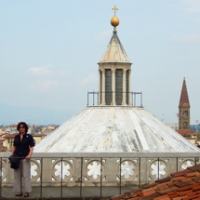
jmusacch@wellesley.edu
(781) 283-2964
Art
B.A., Wellesley College; M.A., Ph.D., Princeton University
Professor of Art
Specialist in Italian Renaissance and Baroque art.
My research focuses on the role of material culture in Italian Renaissance life, encompassing everything from sculpted portrait busts and domestic devotional images to metalwork bridal girdles and embroidered widows’ veils. I’ve published articles and given talks in the United States and abroad on these subjects – as well as on weasels, chickens, and Fascist revivalism – and my two books, The Art and Ritual of Childbirth in Renaissance Italy (1999) and Art, Marriage, and Family in the Florentine Renaissance Palace (2008), investigate these issues in greater depth. I’ve been involved in a variety of related museum exhibitions, too, either as a catalogue author or a curator, most recently for the exhibition Art and Love in Renaissance Italy (2008-2009). But my current project moves in a new direction, to examine Bianca Cappello, a Grand Duchess of Tuscany who tried, and failed, to use the arts to enhance her own very poor reputation.
I teach classes on Italian art and life from about 1260 to 1800. Although my focus is always on the objects, I employ a historical framework that illuminates those objects against, for example, the rise of the mendicant orders, the impact of the Black Death, the growth of secular patronage, the role of women, and the burgeoning interest in scientific inquiry. Like all of my departmental colleagues, I also participate in our team-taught introductory survey. This year-long examination of the history of art from prehistory to the present day is one of the oldest and historically most popular classes at Wellesley and one I remember well from my own undergraduate days.
I’m fascinated by the way the lure of the Ancient and Renaissance worlds extended through the early modern period. This has motivated me to curate exhibitions and give talks on the wide range of prints, photographs, copies, and plaster casts associated with tourism and teaching. Eventually I hope to write a book on the romantic and somewhat skewed interpretation of the Renaissance in the United States during the late nineteenth and early twentieth centuries, an interpretation grounded in the belief that knowledge of past civilizations created social and cultural prestige.
My husband and I spend too much time at flea markets working on our paint-by-numbers collection.
